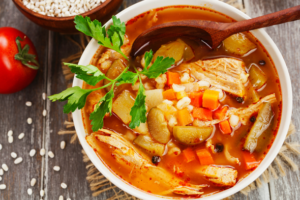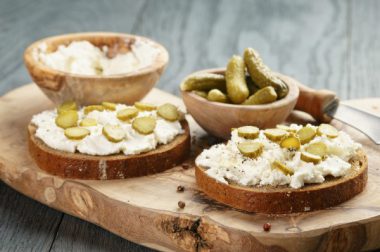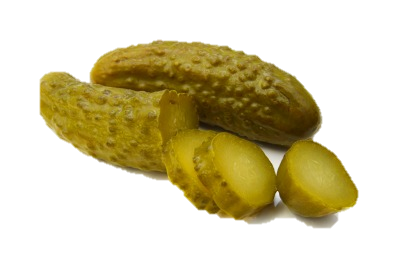Recipes we love
See all recipesOnions and gherkins
An unconventional dish for those who are looking for vegetables with a distinctive taste....

Gherkin soup
This soup is a meal in itself. Not a lot of protein, but enough, and plenty of vitamins and fibre in...
Health benefits
Small but mighty…in terms of salt!
The gherkin itself does not contain sodium, but gets it all from the way it is prepared. The brine used contains sugar, water, and a large quantity of salt: on average, 700 mg to 100 g (or the equivalent of 2 g of salt or sodium chloride).
Gherkins also contain:
- phosphorus
- potassium
- calcium
- selenium
- provitamin A (beta-carotene)
- vitamin B9
Nutritional
composition
When is the right time to eat them?
All year.
Gherkins are available year-round because they are usually sold canned! However, they are harvested in June.
Vegetable patch
or urban balcony?
Gherkins grow well in deep soil that is rich in humus, in sunny spots. They are cultivated in temperate and hot climates.
To learn everything you need to know about growing gherkins, read the page on growing advice.
Choosing
and storing gherkins
Choose your gherkins well:
- If you are lucky enough to have grown gherkins in your garden, you should pick the ones that are small and very firm and start the fermentation process right away.
- For gherkins already found in jars in the shop, it is a question of size and preparation! It is up to you to decide whether you like the large or small ones, with a brine that is more or less spicy depending on the brand, or made with vinegar (most jars today).
- Generally speaking, gherkins should be crunchy. They should be neither too sour nor too spicy, and should give off the aromatic flavors of their brine.
Properly store your gherkins
- Always check the use-by date on the container when you purchase it.
Tips
and tricks
How to prepare gherkins
Gherkins are condiments that go well with numerous dishes to enhance the taste. For gherkins from a jar, all you have to do is drain them before eating. As they are very salty, there is no need to add salt to the recipes you make with gherkins.
Gherkins go well with…
They are a perfect accompaniment for cold cuts, charcuterie, and sandwiches. They are one of the essential ingredients of steak tartare. They also go well with smoked fish.
They also enhance sauces like the French gribiche (with eggs, capers, and herbs) and ravigote (with Dijon mustard, herbs, and more), as well as a celeriac remoulade.
There is also a sweet-and-sour version, made with sugar, said to be ‘Russian-style’. Those gherkins are larger, like mini cucumbers, and are therefore considered to be a vegetable rather than a condiment.
Can everyone eat them?

Young children
Because of their sour flavor and the high salt content, giving young children gherkins is not recommended.
And everyone else
Some people are advised to follow a low-sodium diet because of a health problem (hypertension, heart failure, some liver diseases, etc.). In those cases, it is not advised to eat marinated, salty foods like gherkins.
See plenty of other tips for encouraging children to eat vegetables
Where do they come from?
Origins
Gherkins are widely eaten in Northern European countries (Germany, the Netherlands, and the United Kingdom), and China is the number one consumer of gherkins. France, Italy, China, and India are the biggest producers.
Varieties
Gherkins are cucumbers. However, the cucumbers are harvested before they are fully grown and marinated in vinegar. The vert petit de Paris, the vert de Massy, and the vert fin de Meaux are just some of the varieties prized by connoisseurs. But individual gardeners have their own favorite gherkin varieties, whether large or small, spicy or mild.



 Bell pepper
Bell pepper  Celery
Celery  Vegetable garden: growing soy bean
Vegetable garden: growing soy bean 










